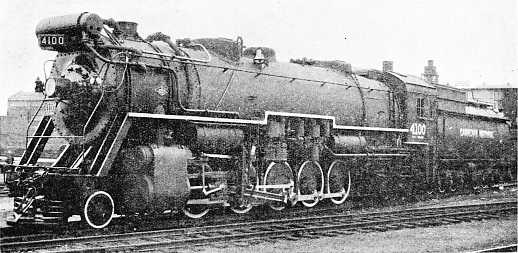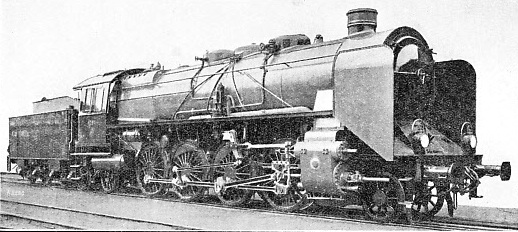LOCOMOTIVES - 57

“GARRATT”-TYPE ENGINE, BURMA RAILWAYS.
MOST of the other countries in the world have learned wisdom from our railway experience, and have left more room round their tracks than we have. Thus the engines that are built on the Continent, and particularly those of the United States and Canada, are generally considerably larger and heavier than our locomotives in this country, though the distance between the tracks is practically the same as it is here.
The vast freight engine of the Canadian National Railways, illustrated below, weighs with its twelve-wheeled tender no less than 325 tons, and measures all but 100 feet in length overall ; it is capable of exerting 3200 horse-power. It is built to a maximum height of 16 feet, which is 3 feet more than the height of most of our big locomotives in this country, and it is proportionately wider also. The tender has sufficient space for no less than 15 tons of coal and 11,000 gallons of water!

TEN-COUPLED FREIGHT ENGINE, CANADIAN NATIONAL RAILWAYS.
Under it, on the same page, you see how the Americans get over the difficulty of designing enormous locomotives “flexible” enough to take the curves in the track easily. This is really like two 2-8-0 locomotives arranged back-to-back under one boiler; and each 2-8-0 frame is constructed in the form of a swivelling truck. Designed to pull with a maximum force of 46¼ tons, this monster weighs, with its tender, 346 English tons in working order.

A VAST “MALLET’’-TYPE ENGINE FOR THE CHESAPEAKE & OHIO RAILROAD OF THE UNITED STATES OF AMERICA.
The big “Garratt’’-type locomotive of the Burma Railways, at the head of this chapter, is another way of surmounting the flexibility difficulty. In this design the boiler is mounted on a frame like a girder bridge, supported by 2-8-0 engines at both ends, which also carry the coal and water supplies, so that no tender is required. Both 2-8-0 engines, of course, are arranged as pivoted trucks, similarly to those of the American Mallet-type engine just described.
The favourite type of engine for express work, both in America and on the Continent, is the 4-6-2, or “Pacific”, of which a characteristic example appears below.

COMPOUND “PACIFIC” EXPRESS ENGINE, PARIS-ORLEANS RAILWAY.
But the increasing weight of trains calls for more “adhesion” weight than is obtainable with six-coupled wheels, and in these days the Continental railways are beginning to build eight-coupled engines for express service, like the German engine on this page. This is of the 2-8-2 type, but the latest French engines, on the Est and PLM Railways, are very powerful examples of the 4-8-2, or “Mountain” type. The curious shields in front of the German engine, by the way, are designed to create an upward current of air, when the engine is running, and so to carry the smoke and steam upwards, and so clear of the driver’s cab.
 COMPOUND 2-8-2 EXPRESS ENGINE, GERMAN STATE RAILWAYS.
COMPOUND 2-8-2 EXPRESS ENGINE, GERMAN STATE RAILWAYS.
You can read more on “Articulated Locomotives”, “Giant American Locomotives” and “Locomotive Giants” on this website.







 COMPOUND 2-
COMPOUND 2-